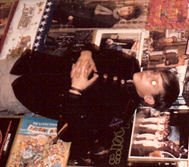By Dr. Michael Tanner
The author, at age 14 in 1968, with pennies on his eyes, wearing a Napoleonic military jacket fashionable at the time.
Albums clockwise from top left:
After Bathing at Baxter’s (Jefferson Airplane),
Blonde on Blonde (Bob Dylan),
Disraeli Gears (Cream),
Magical Mystery Tour (The Beatles),
The Doors,
Everything Playing (Lovin’ Spoonful).
I know the night it happened. I’ve been thinking about it for years. Sure, it might have been the time I put too much air in a tire in a Minneapolis bike shop. It might have been the two thousand pianos I tuned between 1977 and 1983 before I got my head screwed on straight and applied to medical school. But no. It happened at the late show of Jefferson Airplane at the Fillmore East, Thanksgiving 1968.
Bill Graham had just raised ticket prices at the Fillmore from $3/$4/$5 to $3.50/$4.50/$5.50, revealing himself as a capitalist pig. That morning, word on the street had it, Jorma Kaukonen, the Airplane’s lead guitarist, had paid a visit to Manny’s Music on West 48th Street and purchased an olive-green metal loudspeaker called the Mother Dude. Like many groups, the Airplane had been inspired by Cream’s recent US tour to adopt a heavier sound and maximize the volume.
I was sitting in the second row, six feet from Grace Slick and twelve feet from Jorma’s sinister-looking new device. (To Bill’s credit, this was in the days before all the good seats went to music industry people.) They opened with the revolutionary anthem “We Can Be Together.” When Jorma played his first lick through the Mother Dude, the impact on my inci, mallei, stapes, and cochleae was devastating.
After the Fire Marshal closed down the show at 4 AM, as the sun was rising over the East River, my friends and I walked four miles up Second Avenue back to the Upper East Side, on top of the world. It was then that I noticed it for the first time: a dissonant, closely-voiced, four-note chord played on a tinny synthesizer in both of my ears at about 50 decibels. In the early days of smartphones, I had a Casio that reproduced the sound perfectly after I dropped it in the bathtub. The Chord went away after a day or so. But forty years later, at age 54, the sound returned, and it has been with me every single waking second since then. If you let it, the Chord could drive you crazy, but nowadays I only notice it a few times a week.
Silence, however, has permanently left my world.
Would Jorma have sounded as amazing to me at 100 decibels (the volume of the notorious Bellevue fire alarm) as at 120? Probably, but the din was part of the thrill. Should I have worn earplugs? Definitely. But at age 14, I would sooner have gone to the show in a hoop skirt.
No hard feelings, Jorma. This F-sharp diminished chord tone cluster at 3000-4000 Hz–all pitches sharp or flat to the piano–that I am hearing right now and will be hearing for the rest of my life is worth your solo on “Martha.”
Michael Tanner, MD is Executive Editor, Clinical Correlations

